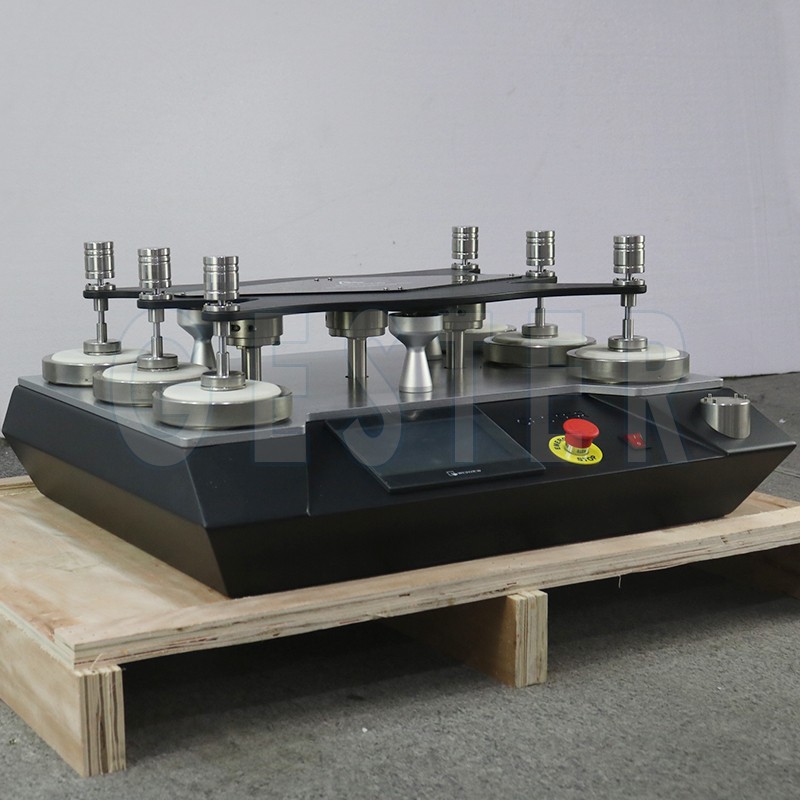The basic formula and performance of PVC leather for car seats, and their effects to the abrasion resistance performance.
Based on the PVC leather of car seats, two test methods of Taber abrasion resistance test and martindale abrasion tester resistance test with different test principles are used to check the effect of texture size, content of wear-resistant additives, type and content of plasticizers on the wear resistance of PVC leather.
The appearance change, quality change and gloss change before and after wear were used to characterize it.
The testing results show that:
Fine texture helps to improve the abrasion resistance of PVC leather;
The addition of fluorosilicone abrasion additives within 7% can significantly improve the abrasion resistance of PVC leather, and the abrasion resistance will decrease after 7%;
Plasticization Under the same condition of the agent content, the abrasion resistance of PVC leather with plasticizer 911 is better than DPHP.
Based on the automobile leather formula, when the plasticizer content increases, the abrasion resistance of PVC leather will be slightly reduced.

At present, in order to maintain or achieve brand competitiveness, major car companies are racing to carry out lean cost control.
How to balance cost, performance and perceived quality is an important issue. As an important functional part of the vehicle interior, the vehicle seat is particularly critical for design and material selection and cost control.
PVC artificial leather is a commonly used seat cover material, and it is also the first artificial leather material invented and applied. Many car companies have gradually decreased the amount of genuine leather and microfiber leather materials on the seats and adopted PVC artificial leather as an alternative material, which not only can save a lot of money Cost, and have a similar appearance and touching feeling to real leather.
Artificial leather formulations for automobiles are usually composed of PVC resin, plasticizers, stabilizers, flame retardants, foaming agents, surface treatment agents and base fabrics. The base fabrics usually include knitted fabrics, non-woven fabrics or microfiber fabrics. The production process Generally there are coating method and calendering method. PVC leather for car seats must have certain light aging resistance (light fastness), weather aging resistance, high and low temperature resistance, rubbing resistance, mechanical properties, chemical resistance, abrasion resistance, and environmental protection.
Because different areas of the seat cover have different requirements for the wear resistance of the material, the wear resistance of PVC artificial leather will affect its application distribution on the seat.
All samples are provided by the same supplier, produced by a coating process, based on the current PVC leather formula that meets the company’s technical standards, and only change certain factors that need to be tested.
Taber Abrasion Tester(CS-10 / 1000 g), Martindale Abrasion Tester (Lissajous figures) Analytical balance, Gloss meter, Color Light Box for valuing the results
Abrasion Resistance Testing Methods
Taber Method
Test all samples, and select 3 samples for each group sample. Test according to QB/T 2726-2005 standard. The sample is a round sample with a diameter of 106 mm (with a mounting hole of about 5 mm in the middle). The grinding wheel is CS-10 type, the applied pressure loaded is 1000 g, the rotation speed is 60 r/min, and the count is 1000 times and 2000 times. Record the appearance change and wear value of the sample (in mg). Know more about Taber Abrasion Tester.
Martindale Method
Test all samples following the GB/T 21196.2~4 standard, and prepare 3 samples for each group. The friction medium is the wool abrasive specified in the standard, the sample is a round sample with a diameter of 140 mm, the load is 1600 g, using the Lissajous track, the speed is 60 r/min, and the count is 10 000 times and 20 000 times. Record the appearance change of the sample at the 60° angle to identify the gloss change of the worn area.
Copyright © 2025 GESTER International Co.,Limited | All Rights Reserved
Hello, please leave your name and email here before chat online so that we won't miss your message and contact you smoothly.